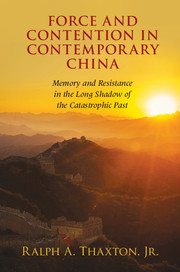 Force and Contention in Contemporary China
Force and Contention in Contemporary China Book contents
- Frontmatter
- Dedication
- Contents
- List of Illustrations
- Acknowledgments
- Cast of Characters for Da Fo Village and Several Other Villages in the Hebei-Shandong-Henan Border Area, 1945–2013
- Maps
- Introduction
- 1 The Violent Dawn of Reform
- 2 Contemporary Tax Resistance and the Memory of the Great Leap
- 3 Birth Planning and Popular Resistance
- 4 Rural Schools and the “Best Citizens of the State”: The Struggle for Knowledge and Empowerment in the Aftermath of the Great Leap
- 5 Official Corruption and Popular Contention in the Reform Era
- 6 The Rise of the Electricity Tigers: Monopoly, Corruption, and Memory
- 7 The Defeat of the Democratic Experiment and Its Consequences
- 8 Contentious Petitioners and the Revival of Mao-Era Repression
- 9 Migration and Contention in the Construction Sector
- 10 The Rise of the Martial Artists and the Two Faces of Mafia
- Conclusion: Big Questions and Small Answers from Da Fo
- Bibliography
- Index
- Miscellaneous Endmatter
3 - Birth Planning and Popular Resistance
Published online by Cambridge University Press: 05 August 2016
- Frontmatter
- Dedication
- Contents
- List of Illustrations
- Acknowledgments
- Cast of Characters for Da Fo Village and Several Other Villages in the Hebei-Shandong-Henan Border Area, 1945–2013
- Maps
- Introduction
- 1 The Violent Dawn of Reform
- 2 Contemporary Tax Resistance and the Memory of the Great Leap
- 3 Birth Planning and Popular Resistance
- 4 Rural Schools and the “Best Citizens of the State”: The Struggle for Knowledge and Empowerment in the Aftermath of the Great Leap
- 5 Official Corruption and Popular Contention in the Reform Era
- 6 The Rise of the Electricity Tigers: Monopoly, Corruption, and Memory
- 7 The Defeat of the Democratic Experiment and Its Consequences
- 8 Contentious Petitioners and the Revival of Mao-Era Repression
- 9 Migration and Contention in the Construction Sector
- 10 The Rise of the Martial Artists and the Two Faces of Mafia
- Conclusion: Big Questions and Small Answers from Da Fo
- Bibliography
- Index
- Miscellaneous Endmatter
Summary
When Deng Xiaoping and his allies launched the one-child birth planning policy between 1980 and 1983, a step Tyrene White calls “the most extensive, aggressive, and effective attempt ever made to subject child-bearing to direct state control and regulation,” it was received in the countryside with suspicion and resistance by both farmers and some of the Communist Party cadres whose mission it was to implement it. Western scholarship on the policy tends to focus on the process whereby the central party-state overcame this resistance, thereby imposing its policy, or on popular acceptance of a modified version of its virtuous – though violent – demographic scheme. While such approaches certainly help explain some of the pedestrian forms of popular resistance to state attempts to manage child bearing, they slight a fundamental reason for the swift formation of popular resistance to the birth-planning campaign: this campaign threatened to overstep the boundaries of even the one-child policy and to rely on repressive methods that raised the specter of the Great Leap past, in which the perpetrators of Mao's famine had imposed a de facto no-child policy in Chinese villages, preventing villagers from bearing children. Behind the hostility to the one-child limit, in other words, was the memory of the Great Leap's harm, which had all but destroyed the credibility of official interference in family procreation.
This chapter investigates the evolution of resistance to the implementation of the center's birth-control policies in Da Fo village over the course of the 1980s and particularly the 1990s. The evidence from Da Fo suggests that Chinese villagers had kept alive memories of the party-state as the enemy of motherhood and child bearing. To many villagers, the regimentation of child bearing in the 1990s suggested a transposition of the Maoist context of the Great Leap to that of reform. What they actually were resisting was not the one-child policy per se but rather the attempt of a powerful central party-state to once again secure control over the entire process of procreation. Furthermore, the memory of the Great Leap famine and villagers’ delayed retaliation against Leap-era party leaders affected the willingness of Da Fo's leaders to press the birth-planning policies of Liangmen township, ultimately resulting in the defeat of the most stringent interpretations of the center's policies and their replacement by a conciliatory “bottom-line” local policy that accommodated tillers’ unwillingness to accept a one-child limit on their reproduction.
- Type
- Chapter
- Information
- Force and Contention in Contemporary ChinaMemory and Resistance in the Long Shadow of the Catastrophic Past, pp. 92 - 124Publisher: Cambridge University PressPrint publication year: 2016
